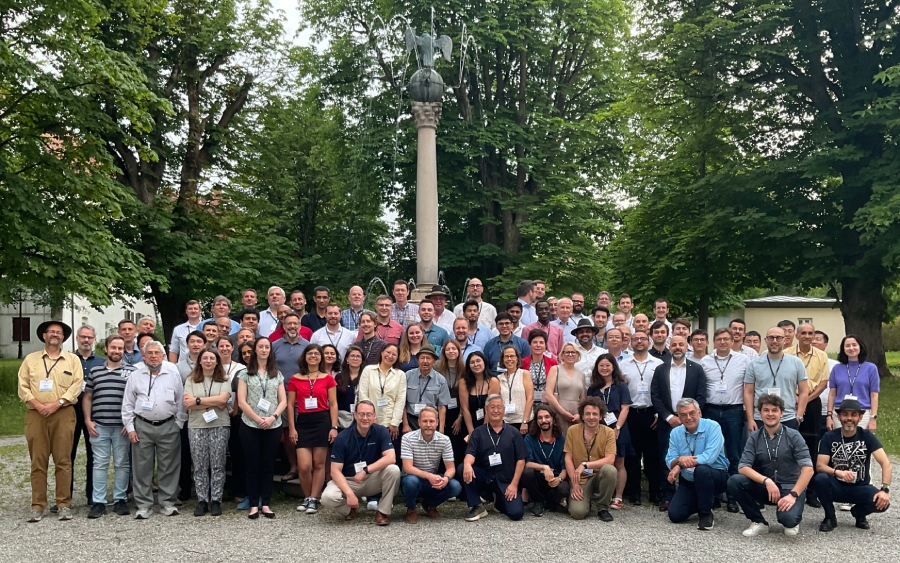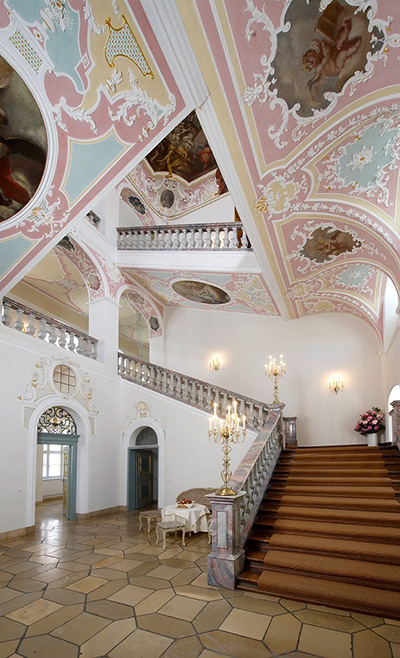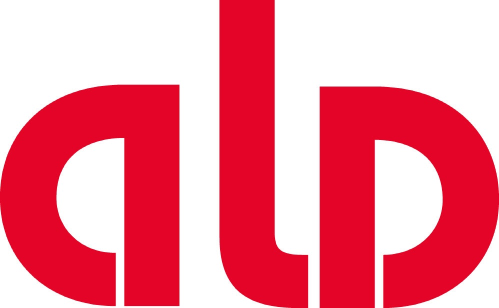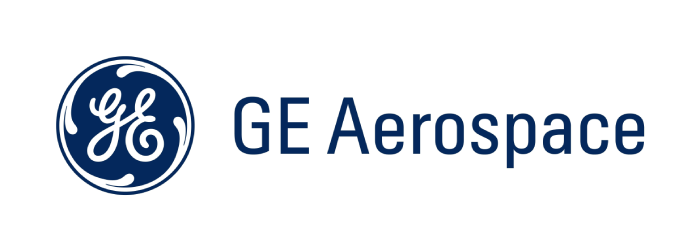
June 22 - 27, 2025
Irsee, Germany
Thermal and Environmental Barrier Coatings VII Online Program >
About This Conference
This conference will be the seventh in a series of conferences sponsored by ECI at Irsee, Germany on Thermal Barrier and Environmental Barrier Coatings. Thermal Barrier Coating (TBC) Systems continue to be key materials technology that offer great benefit to the operation of gas turbines for aviation, marine and land-based power generation, and for aircraft engines, gas turbine shipboard engines, land based industrial gas turbine engines, and, recently, for diesel reciprocating engines. For protecting silicon- based ceramic matrix composites for similar applications, Environmental Barrier Coatings (EBCs) have become an area of increased materials research studies. It is noteworthy that research in TBCs and EBCs has accelerated greatly in the past twenty years and that this work has resulted in the commercial and military use of new bond coats, low conductivity coatings, coatings that resist degradation induced by environmental deposits ingested into the engine, and the introduction of EBCs into service. Current research includes development of coatings capable of operating at higher temperatures, new
and cost-effective manufacturing routes especially in the area of thermal spray, and recently TBCs that will resist reaction with deposits such as CMAS or volcanic ash. Additional areas for EBC of research include new silicide-based materials and multi-element refractory alloys where the coatings are key for successful introduction of the materials into application. TBC and EBC systems are now key elements in the design of new and advanced engines and are enabling many new designs with improved efficiencies and higher thrusts. Extensive research and development of TBCs and EBCs is being carried out in every major industrialized country by industry, academia, and national institutions and laboratories.
ECI sponsored very successful conferences at Kloster Irsee, Germany during August 17-22, 2003, August 12-17 2007, August 7-12 2011, June 22-27, 2014, June 24-29, 2018, and June 19 – 24, 2022. Over 500 researchers and practitioners in total have attended these conferences. Several technologies that were in the developmental phase and reported on at previous conferences are now being deployed and can be discussed.
Thermal barrier and environmental barrier coatings are complex, multi-layered, and multi-material systems with many variants related to composition, processing and microstructure. Further understanding of the science and behavior of these materials that will result in further advancement of the technology. Progress made within high resolution and scale bridging characterization tools can play a major role. The field has attracted a diverse group of scientists and engineers especially in the USA, Canada, Europe, Australia, Japan and China and combines ceramics, metals, metal-ceramic interfaces, processing, mechanisms of TBC and EBC performance and degradation including environmental attack and oxidation, thermal transport, diffusion and applications in a variety of aggressive environments.
Previous Conference Information
Conference Outline
The conference will address the multi-disciplinary nature of thermal barrier and environmental barrier coatings and will attempt to bring together those who have expertise in specific aspects of the materials involved, processing with conventional and innovative methods, mechanics and chemistry of degradation, newer materials as alternatives to yttria stabilized zirconia, high-temperature oxidation and corrosion including CMAS attack, thermal and radiative heat transport, diffusion, high temperature creep and sintering phenomena as well as engineering design. In addition, the interaction of the various layers with different substrates (Ni-, Co-, Ti-, Silicide-, CMC-based) that cover applications in aero- and land-based gas turbines, diesel engines, and rocket applications will be discussed.
Conference Organization
Chairs
Dr. Bruce Pint, Oak Ridge National Lab, USA, LEAD
Professor Elizabeth Opila, University of Virginia, USA
Brian Hazel, PWA, USA
Dr. Uwe Schulz, DLR, Germany
Dr. Robert Vasen, Research Center, Julich, Germany
Dr. Arturo Flores-Renteria, Siemens Energy, Germany
Dr. Bryan Harder, NASA, USA
Dr. Ram Darolia, GE Aerospace (Retired)
Advisory Committee
Dr. Mike Maloney, PWA, (Retired)
Prof. Carlos Levi, UCSB, USA
Dr. Margeux Wallace, GE Research
Dr. Ravi Shankar Naraparaju, DLR, Germany
Dr. Gyn Brewster, Rolls Royce, UK
Session Descriptions
Conference Fees and Registration
The conference fee includes registration, accommodations for the nights of Sunday through Thursday (June 22-26; check-out on Friday, June 27); all meals and coffee breaks included from dinner Sunday evening through Friday lunch; an off-site excursion on Wednesday; and all taxes. Incidental fees (telephone calls, laundry, minibar etc.) are billed to your personal account by the hotel.
ALL PARTICIPANTS (INCLUDING MEMBERS OF THE ORGANIZING COMMITTEE AND INVITED SPEAKERS) ARE REQUIRED TO REGISTER.
Registration is Full.
Please email Renee [at] engconfintl.org if you have questions or need more information.
ECI cannot guarantee hotel accommodations without advance payment. Registrations and/or payments received after May 22, 2025 will be confirmed on a first-come, first-serve basis, if space is still available.
| Registration Type | Early bird Registration by 22 May 2025 | Regular Registration After 22 May 2025 |
| Participant (single occupancy-or-sharing room with a personal guest; guest fee additional) | US $2,570 | US $2,770 |
| Participant (sharing a room with another participant) | US $2,350 | US $2,550 |
| Bona fide Graduate Students* (sharing a room with another student) To qualify, students must upload proof of current status during registration – copy of current Student ID or a letter from your university confirming your student status) | US $2,040 | US $2,240 |
| Bona fide Graduate Students* (upgrade to single room)To qualify, students must upload proof of current status during registration – copy of current Student ID or a letter from your university confirming your student status) | US $2,260 | US $2,460 |
GUEST FEES Personal Guests may not attend technical sessions. | ||
| GUEST REGISTRATION All Conference Meals & Activities – A personal guest or accompanying person sharing bedroom with a conference participant; includes all conference meals and activities; no technical sessions. | US $1,520 | US $1,520 |
If you plan to bring children to the conference, please contact Renee Smith for pricing.
Student Rates
*ECI provides discounted registration rates for bona-fide graduate students in exchange for onsite logistics support, such as: audio visual (AV) and speaker coordinator(s), on-site registration check-in support, mic runners, photographers, and more. ECI will email all students one week prior to the start of the conference to ask for on-site help preferences. We appreciate your participation and support!
Cancellation Policy
Click here for information on ECI’s Registration Cancellation Policy
Pre Conference Hotel Reservations
Kloster Irsee can offer pre-conference reservations for up to three days prior to the start of the conference. They are sold out starting Friday night, June 27 and recommend that you contact the Klosterbrãu Hotel (https://www.irsee.com) which is just across the courtyard in Irsee should you require post conference lodging in Irsee.
PreConference Hotel Reservation Form.
Sponsors
Previous Conferences in this Series
Thermal and Environmental Barrier Coatings
Aug 17-22, 2003
Irsee, Germany
Conference Chairs:
David R. Clarke, University of California Santa Barbara, USA
Anthony Evans, Princeton University, USA
Manfred Ruehle, MPI, Germany
Thermal Barrier Coatings II
August 12-17, 2007
Irsee, Germany
Conference Chairs:
Ram Darolia, GE Aviation, USA
Michael J. Maloney, Pratt & Whitney, USA
Kevin Hemker, Johns Hopkins University, USA
Yutaka Kagawa, University of Tokyo, Japan
Christoph Leyens, Technical University of Brandenburg at Cottbus, Germany
Thermal Barrier Coatings III
Aug. 7-12, 2011
Irsee, Germany
Conference Chairs:
Michael J. Maloney, Pratt & Whitney, USA
Uwe Schulz, German Aerospace Center, Germany
David Rickerby, Rolls-Royce, UK
Ram Darolia, GE Aviation, USA
Odile Lavigne, ONERA DMSM/MAT, France
Hideyuki Murakami, National Institute of Materials Science, Japan
Hongbo Guo, Beihang University, China
Thermal Barrier Coatings IV
June 22-27, 2014
Irsee, Germany
Conference Chairs:
Uwe Schulz, German Aerospace Center, Germany
Ram Darolia, GE Aviation, USA
Michael J. Maloney, Pratt & Whitney, USA
Thermal Barrier Coatings V
June 24 – 29, 2018
Irsee, Germany
Conference Chairs:
Robert Vaßen, Forschungszentrum Jülich GmbH, Germany
Brian Hazel, Pratt & Whitney, USA
Uwe Schulz, German Aerospace Center, Germany
Ram Darolia, GE Aviation, USA
Michael J. Maloney, Pratt & Whitney, USA
Thermal Barrier Coatings VI
June 19 – 24, 2022
Irsee, Germany
Conference Chairs:
Brian Hazel, Pratt & Whitney, USA
Uwe Schulz, German Aerospace Center, Germany
Mike Maloney (retired), Pratt & Whitney, USA
Robert Vaβen. Research Center, Julich, Germany
Ram Darolia (retired), GE Aviation, USA
Venue Information

Nestling in the Alpine Foreland of the Allgäu and located only a few kilometers from walled town of Kaufbeuren, the former Benedictine monastery at Irsee – founded in the 12th century – now houses a modern conference center The magnificent Baroque church and the harmoniously designed four-winged monastery, surrounded by a well-kept park, away from major highways and yet easily reached, is particularly suitable for the conference. The center offers a broad range of leisure activities including a bierstube in the cellar of the monastery and a play room with pool, table tennis and tabletop football. There is also a bocce court, and a sauna available for guests. Nearby are many jogging trails, fitness trails, a tennis center, walking and hiking trails. Across the court from the center is the Irsee brewery where conference attendees can enjoy beer directly from its source. Note that there are no televisions in the bedrooms; however, one may be rented.

The nearest major airport is Franz-Josef Strauss Airport in Munich and their web-link provides a great deal of useful information, including information for booking airport hotels.


Kloster Irsee/Swabian Conference Center at Irsee is a good starting point for excursions and sightseeing tours to the Allgäu Mountains, to Lake Constance, to Austria and Switzerland. For those who plan to extend their stay, popular day-trips are to the Castles of Linderhof and Neuschwanstein (built by the Bavarian King Ludwig II), the scenic Tannheimer Valley and the Pfaffenwinkel with its famous Baroque churches (Wieskirche).
More information about Kloster Irsee can be found at www.kloster-irsee.de
Transportation to Conference Site
The Swabian Conference Center at Irsee is nestled in the Alpine Foreland of the Allgäu, yet is conveniently located near Munich and is easily reached by rail or road. For those traveling from the airport by train, one can reach the Munich Main Station (Hauptbanhof) in several ways: (1) by Lufthansa Airport Bus. Departures are every typically 20 minutes for the 45 minutes trip. Cost is approximately 15 € one- way and 25 € roundtrip. (2) By Rapid Transit Train (“S-ban” – either S1 or S8). Departures are every 20 minutes for the 41 or 45-minute trip. (3) By taxi. The trip takes approximately 40-minutes and the price should be discussed with the driver.
From the Munich Main Station there are through trains to Kaufbeuren (about an hour ride). In front of Kaufbeuren Station there is a taxi stand.
How to get there - Kloster Irsee (kloster-irsee.de)
Bus Schedule
General Information about ECI
Engineering Conferences International (ECI) is a not-for-profit, global engineering conferences program, originally established in 1962 that provides opportunities for the exploration of problems and issues of concern to engineers and scientists from many disciplines.
The format of the conference provides morning and late afternoon or evening sessions in which major presentations are made. Poster sessions will be scheduled for evening discussion as well. Available time is included during the afternoons for ad hoc meetings, informal discussions, and/or recreation. This format is designed to enhance rapport among participants and promote dialogue on the development of the meeting. We believe the conferences have been instrumental in generating ideas and disseminating information to a greater extent than is possible through more conventional forums.
All participants are expected both to attend the entire conference and to contribute actively to the discussions. The recording/photographing of lectures and presentations is forbidden. As ECI conferences take place in an informal atmosphere, casual clothing is the usual attire.
Smoking is prohibited at ECI conferences and conference functions.





